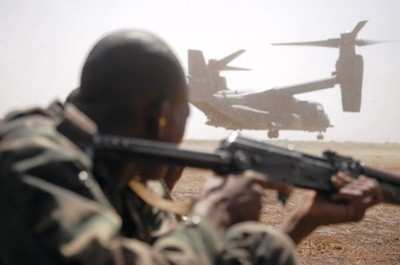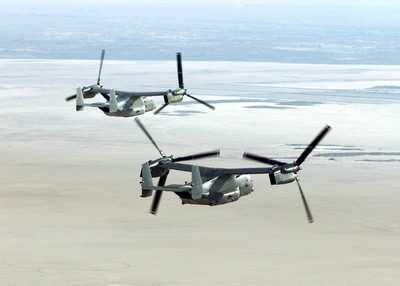Aircraft Supported Exercise Flintlock 2009
The military's fleet of Osprey tilt-rotor aircraft is seeing
more light under its wheels. Four CV-22s from the 8th Special
Operations Squadron at Florida's Hurlburt Field recently returned
after completing their first operational deployment supporting
Exercise Flintlock 2009 in November in Bamako, Mali.

The aircraft supported the training exercise in the
Trans-Saharan region designed to build relationships and capacity
and to enhance African nations' ability to patrol and control their
sovereign territory.
The exercise included personnel from 15 countries, and the CV-22
served as a platform for multinational training. Specifically, the
aircraft was used to transport Malian and Senegalese special
operations forces and their leadership teams.
"We did long range, vertical lift, and dropped (teams) off at a
landing zone," said Capt. Dennis Woodlief, an 8th SOS pilot. "They
practiced their ground movements, then we brought them back."
Missions like this allowed the CV-22 to take advantage of its
unique capabilities as a tilt rotor aircraft, said Lt. Col. Eric
Hill, the 8th SOS squadron commander.
"The tyranny of distance in the African continent is amazing," he
said. "We were able to go over 500 nautical miles, infiltrate a
small team for them to run their exercise, and bring them back all
the way to home base without doing an air refueling stop. And we
were able to do that in the span of about four hours."
"It would take the MH-53 (Pave Low) twice, sometimes three times
as long (to do these missions)," Captain Woodlief said. "And we did
it with just one aircraft."
Colonel Hill said the CV-22 is an "unprecedented capability."
And with the new capability, there were also new lessons to be
learned.

"We learned some lessons like we always do on different
equipment we'd like to have and requirements that we'll have in the
future," he said.
Many of those lessons revolve around tailoring maintenance
packages for future deployments.
Members of the 1st Special Operations Helicopter Maintenance
Squadron deployed to Bamako in support of the 8th SOS. Because the
exercise was held at a remote location rather than an established
base, one of the maintenance challenges was self-deploying with all
the parts and equipment they needed to keep the CV-22s operational
for the entire exercise, and for the cumulative 10,000 nautical
mile trans-Atlantic flights.
"We have a laundry list about three pages long of things we'd
like to take next time," said Master Sgt. Craig Kornely, the
squadron's lead production supervisor. "As we grow into the
machine, we realize our needs for equipment and resources."
But despite the challenges of operating a new aircraft for the
first time overseas and in an austere environment, the squadron had
a perfect mission success rate during the exercise.

"We had zero maintenance cancels, zero delays, and we executed
100 percent every time," Captain Woodlief said. "I think we went
above and beyond everyone's expectations."
 NTSB Final Report: Cessna 177B
NTSB Final Report: Cessna 177B ANN's Daily Aero-Term (05.08.25): Final Approach Fix
ANN's Daily Aero-Term (05.08.25): Final Approach Fix Aero-News: Quote of the Day (05.08.25)
Aero-News: Quote of the Day (05.08.25) ANN's Daily Aero-Term (05.09.25): Estimated (EST)
ANN's Daily Aero-Term (05.09.25): Estimated (EST) ANN's Daily Aero-Linx (05.09.25)
ANN's Daily Aero-Linx (05.09.25)





